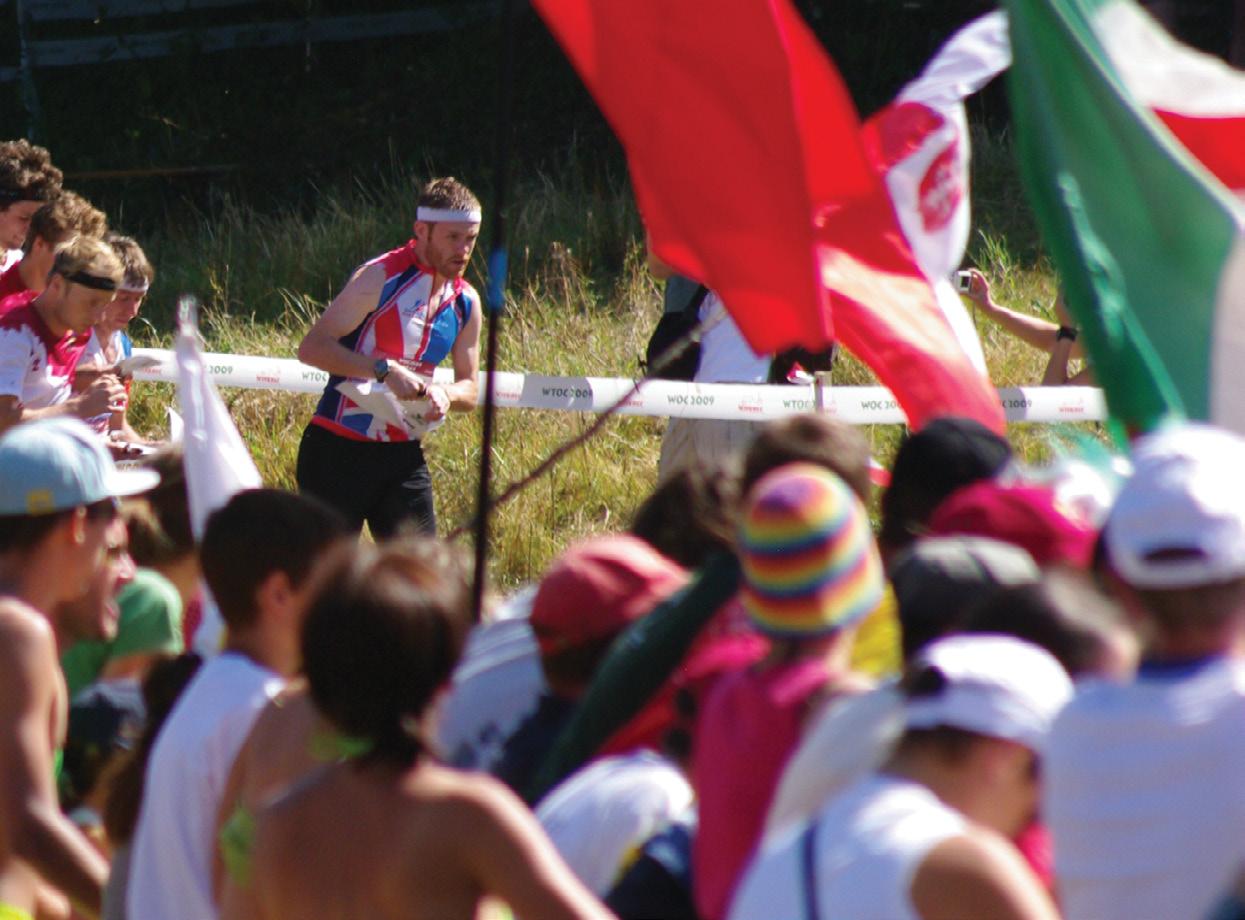
10 minute read
WORLD ORIENTEERING CHAMPS
Kathryn Ewels Shines at WOC 2009 in Hungary
Wendy Read
AUSTRALIAN Boomerangs member Kathryn Ewels (VIC) went within seven seconds of a medal in the Sprint final at the World Orienteering Championships. Starting in the first third of the field, Ewels clocked 16min 0.9sec for the 2.62 km course, which put her at the head of the leader board for over 15 minutes. Four competitors eventually bettered her time, with victory going to Sweden’s Helena Jansson in 15min 7.8sec. Swiss Simone Niggli was third, just 6.2secs ahead of Ewels. The tranquil surroundings of the Miskolc Zoo turned into an exhilarating Orienteering Sprint championships arena. Participants in the Hungaria Cup flocked in great numbers from their own midday Sprint event in downtown Miskolc to the sunny zoo parklands to watch the excitement of the Men’s and Women’s Sprint Final unfold. With temperatures still close to 30degC at 5:30pm, Australia’s hopes rested solely on the shoulders of Kathryn Ewels, the twentieth starter in the women’s Final. And what a performance! Kathryn had Russian competitors starting immediately before and after her. “A Russian sandwich,” was the description given by team coach/manager Rob Lewis of Kathryn’s start position. At the first television checkpoint, the excitement began to build as the race commentator announced, “Kathryn Ewels is the new second best time!” Kathryn had caught Galina Vinogradova who had started one minute ahead of her. The Russian had placed 4th in the WOC Sprint in 2008 so Kathryn was indeed running well. By the first spectator control, Kathryn was holding 3rd place, but as only the twentieth starter from a field of 45 many top quality runners were yet to finish. The split timing results showed an amazing performance in the second half of Kathryn’s race, with an incredible burst of speed from the #11 control through to the finish, which secured her 5th placing. The 2006 World Sprint champion, Hanny Allston (TAS), missed the final after a major mistake midway through her course when, on a leg of around 150 metres, she lost 2min 10sec to the leader and dropped from 4th to 18th, where she finished overall. Only the top 15 in each heat go into finals. In other results, Grace Crane (15th) and Hanny Allston (18th) put in strong performances in the Middle Distance final. For some time the Australian girls held first and second place on the results board, causing excitement and anxiousness amongst the Team, Aussie supporters and especially the commentator. And in the Long Distance final Hanny Allston and Kathryn Ewels finished 19th and 22nd respectively.
Photo: Peter Hobbs RESULTS Sprint Qualification
Heat A – Shannon Jones 16th Heat B – Kathryn Ewels 9th Heat C – Hanny Allston 18th
Sprint Final
1. Helena Jansson (SWE) 15:07.8 2. Linnea Gustafsson (SWE) 15:49.7 3. Simone Niggli (SUI) 15:54.7 4. Signe Soes (DEN) 15:58.3 5. Kathryn Ewels (AUS) 16:00.9 6. Anni-Maija Fincke (FIN) 16:01.5
Middle Distance Qualification
Heat A – Hanny Allston 11th Heat B – Grace Crane 11th Heat C – Jasmine Neve 24th
Middle Distance Final
1. Dana Brožková (CZE) 37:09 2. Marianne Andersen (NOR 37:19 3. Simone Niggli (SUI) 37:58 4. Minna Kauppi (FIN) 38:20 5. Merja Rantanen (FIN) 38:59 6. Helena Jansson (SWE) 39:07 15. Grace Crane (AUS) 42:12 18. Hanny Allston (AUS) 43:01
Long Distance Qualification
Heat A – Grace Crane 17th Heat B – Hanny Allston 5th Heat C – Kathryn Ewels 5th
Long Distance Final
1. Simone Niggli (SUI) 77:26 2. Marianne Andersen (NOR) 79:18 3. Minna Kauppi (FIN) 79:36 19. Hanny Allston (AUS) 87:49 22. Kathryn Ewels (AUS) 89:39
Relay
1. Norway 2:13:10 2. Sweden 2:13:28 3. Finland 2:15:25 4. Switzerland 2:16:12 5. Czech Republic 2:16:26 6. Russia 2:20:10 9. Australia 2:32:23 9.1 Grace Crane 39:43 (4.9km) 9.2 Kathryn Ewels 55:42 (6.9km) 9.3 Hanny Allston 56:58 (7.2km)
Hanny Allston chosen to read the Athletes’ Oath
A proud moment for both Hanny Allston and the Australian Boomerangs Orienteering Team as she was invited to read the Athletes’ Oath during the official opening of the 26th World Orienteering Championships in Miskolc, Hungary. Accompanied by one of Hungary’s best orienteers, Gabor Domonyik, the Oath was recited in both Hungarian and English on behalf of all athletes.
Orienteering
in Hungary
text & photos: Peter Hobbs (Dandenong Ranges OC, Victoria)
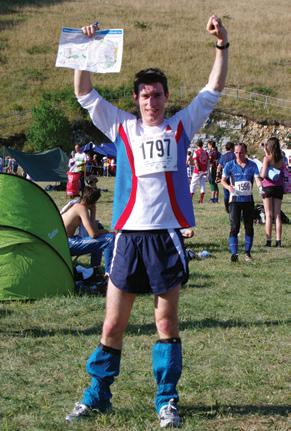
Can you imagine 5000 parochial and patriotic spectators at an Orienteering event? Seven hundred elite international competitors; upwards of 1500 public competitors? Imagine raucousness, fun, live commentary and GPS competitor tracking, mixed with vibrant colours, perfect weather and sun-baking. Add some dramatic race finishes and personal orienteering achievements and you have a snapshot of the brilliant experience I had being part of the World Orienteering Championships carnival held in Miskolc, north eastern Hungary on 16-23 August 2009.
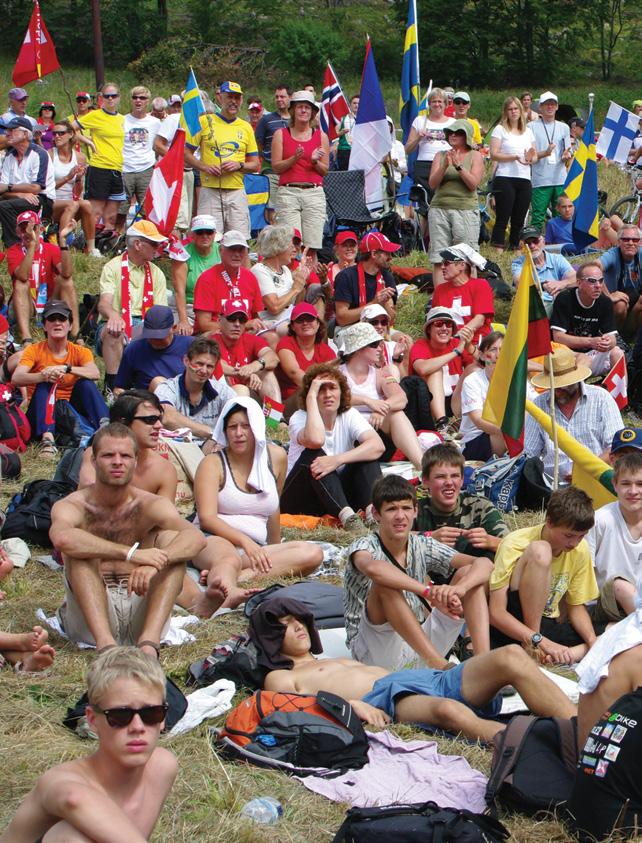
IT was early July 2009; I had already booked a two month holiday to explore Eastern Europe. I could not believe my luck when I stumbled upon the WOC website and learnt that the carnival would be held during precisely the week that I intended to visit Hungary. I immediately entered two public, Hungaria Cup (HC) events – one Middle Distance and one Sprint – and booked accommodation and meals at the official WOC Village, located at the University of Miskolc. Each day of the carnival was arranged so that, for instance, the public HC Sprint event was held during the morning and the WOC Sprint event was held in the afternoon at a nearby location. This allowed non-elites to compete in their event then be a part of the raucousness and fun of the WOC event later in the day. The Middle Distance HC event was staged in a forested area called Bukkszentkereszt, some 45 minutes from Miskolc. Upon arriving, I was absolutely amazed at the scene before me; spectators, competitors, women sun-baking in bikinis, young people and old people, not to mention the hundreds that were already competing in the forest. There were flags, tents, promotion caravans and vibrant colour everywhere. The spectator area was located on a large oval including the finish chute spanning the entire length of the western boundary. I had simply never seen anything like it at an Orienteering event before. Armed with my northern hemisphere compass and SI-stick, I made my way to the Start area. There were so many people milling about that I was barely able to find a patch of grass to perform my last minute quad and calf stretches. Competitors were lined up according to start time in groups of about 25 and starts were at one minute intervals. After five or so minutes it was my group’s turn to start, and with a growing sense of anticipation, I was off. Interestingly, the course began with a 200m sprint to the ‘graveyard’, where I located the ‘21C’ map pile amidst a plethora of 25 other courses. I grabbed my map, took a few seconds to orientate myself, then sped off down a track which provided the perfect ‘handrail’ into control #1. One of my orienteering rules is ‘sure start’ which basically means I place great importance on cleanly (and slowly, if necessary) navigating between the start triangle and the first control. Having located the first control easily and quickly, my confidence was up, my radar was on and I headed confidently to the second control. To cut a long story short, I completed the 3.8 km course in a time of 30:26, earning second place. I was ecstatic as it was probably my cleanest and fastest bush-O performance. My only real error was traversing a hillside at too high an elevation then having to descend slightly in order to reach control #6. Contrary to expectations, I actually found the forest terrain for the Middle Distance event to be quite easy. The map featured classical spur-gully topography including a number of steep hills and a smattering of tracks. Due to a lack of undergrowth and boulders, visibility was excellent allowing identification of controls from afar. The ground was covered with dry leaves and, apart from the odd fallen tree branch, I found it easy to run through the

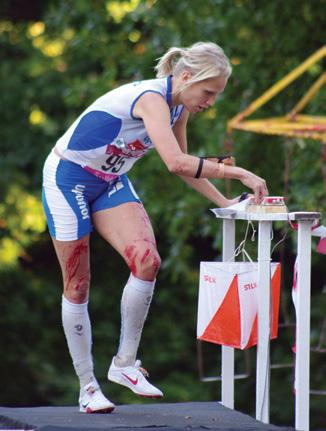
Peter was pleased with his run


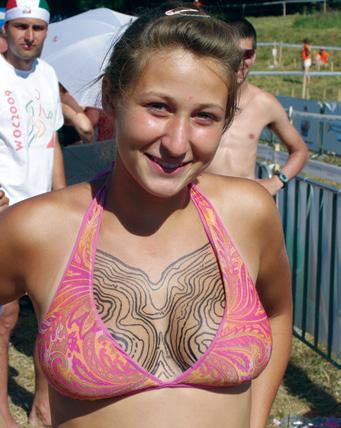




forest which allowed additional time for map contact and route planning. Despite many other competitors gazing at my Asics runners with disbelief accompanied by comments that these would fail to provide adequate grip in the forest, I had no such trouble. Luckily for me the weather was fine! The next day, which featured both the HC and WOC Sprint events, was definitely the highlight of the carnival for me. The HC Sprint event was held during the morning on a superb 1:4000 scale map covering a 800m by 400m section of central Miskolc, including the town square which had been transformed into a vibrant scene similar to that for the Middle Distance event, described earlier. Typical of many European cities, the map featured an astounding number of narrow alleyways and intricate courtyards which had been opened specially for the event. Cars were barred from entering the competition area and you would have been forgiven for thinking that the city had been taken over by orienteers! Temperatures soared to what seemed like 35 deg. Starts were at one minute intervals in groups of about 20. It was hectic, to say the least. I managed to navigate cleanly and quickly to the first control and apart from a near-miss encounter with a tram and a 10sec error whilst approaching control #8, I had an excellent run. It reminded me of a hectic foot chase in a James Bond movie; you would dart down an alleyway, then burst onto a main pedestrian thoroughfare, then run past bemused customers at an outdoor café, then cross a bridge, sprint across a park, then dart into a small courtyard in pursuit of a well hidden control. And so it went. I again finished second in my division, only 20secs behind the winner. I was absolutely rapt with my performance. But the excitement of ‘Sprint Day’ had only just begun as the WOC Sprint finals were held at the Miskolc zoo that evening. Course setters had designed the course to maximize spectators’ vision of the event. Spectators passed under a ramped section of the course into a large amphitheatre around which the start chute, finish chute and a 300m section in the middle of the course were located. The excitable commentator combined with on-course footage, GPS tracking and live times gave spectators a virtual armchair view of the event. The event was being broadcast live on TV into six countries and I estimate that there must have been at least 5000 spectators in attendance. The atmosphere was nothing short of electric. The women’s course began with a number of controls amidst bushland and animal enclosures within the zoo grounds, before passing via the spectator area, into another bush area and then onto the finish. The bush must have been either thick or prickly as numerous competitors emerged with blood covering their legs. As finishers began to arrive and official times were appearing on the results board, I managed to snap a brilliant action shot of Australian Kathryn Ewels as she sprinted purposefully past the spectator amphitheatre and disappeared into the final section of the course. Seemingly not two minutes later, Kath emerged from the bush so quickly that even the commentator had been caught by surprise, announcing with a shock that she had moved into provisional first place. With an Australian flag already draped around my neck, I felt quite patriotic! I also attended the WOC Middle Distance and Relay finals which were also highly vibrant and exciting events. The men’s Relay ended in high drama when midway through the final leg, the leading Swedish runner had a stick imbedded 12cm into his leg, requiring urgent medical attention. Consequently, runners of the second (French), third (Norwegian) and fourth (Czech) placed teams, immediately stopped to render assistance, effectively forfeiting the race for their respective teams. What a fine example of sportsmanship. Well done to the Australian girls team for doing us all proud. To anyone who has considered travelling to Europe and being a part of the WOC carnival; just do it. It’s a truly brilliant experience.
